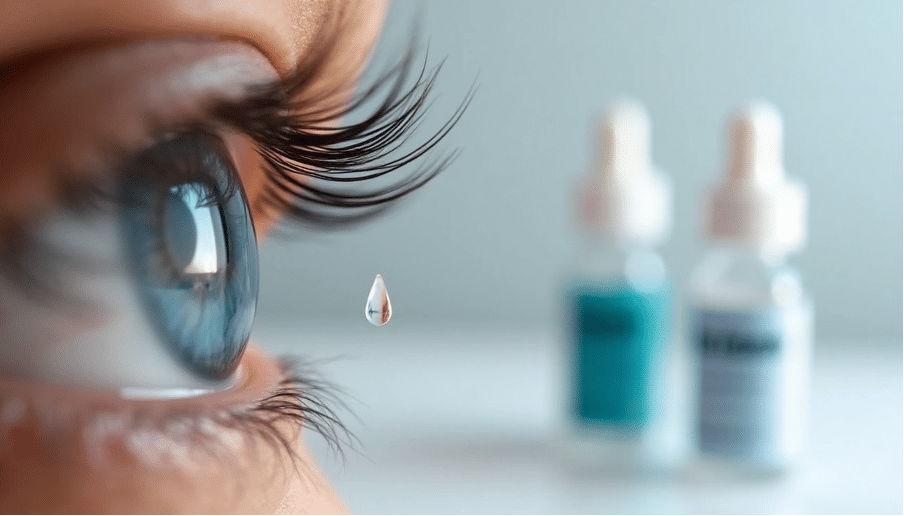Did you know that over 95% of patients report dry eye symptoms after laser eye surgery? The right eye drops play a significant role in your recovery and comfort after laser eye surgery. Your healing mostly happens within the first day, but proper aftercare remains vital for the best results. Each type of eye drop serves a specific purpose during your recovery – antibiotics prevent infections, steroids reduce inflammation, and artificial tears keep your eyes comfortable as your vision improves.
Most patients need eye drops from several weeks to a few months after the procedure. LASEK’s recovery process takes up to three to four days longer than LASIK. Your healing eyes need preservative-free artificial tears because preservatives can cause irritation.
A proper eye drop routine helps prevent complications like corneal haze and delayed healing. This piece will guide you through everything you need to know about managing eye drops after laser eye surgery.

Understanding the Role of Eye Drops in Recovery
Eye drops are the life-blood of your post-laser eye surgery care plan. These medications serve many key roles that affect your recovery outcome and comfort.
Why eye drops are essential after laser eye surgery
Laser eye surgery temporarily disrupts your eye’s natural systems. This creates specific vulnerabilities that eye drops help fix. Your vision quality could suffer from complications if you don’t use the drops properly. Antibiotic drops prevent infections during the early healing phase when your cornea needs the most protection. This protection matters because infections after LASIK are very rare (<0.1%) thanks to patients using antibiotic drops consistently.
Steroid drops control inflammation—your body’s natural response to surgery. These drops create the best environment for corneal healing. This leads to faster visual improvements and helps prevent complications like corneal haze.
How they support healing and comfort
Different types of eye drops help your recovery in unique ways:
- Antibiotic drops (like Oftaquix/Exocin): Kill harmful bacteria, typically used for about a week post-surgery.
- Steroid drops (like Pred Forte/Maxidex): Reduce swelling and irritation, usually needed for 1-4 weeks based on how well you heal.
- Artificial tears (like Hydramed/Thealoz/Hyaloforte Duo): Help with dryness, which affects approximately 50% of patients following treatment.
These medications work together to help your cornea heal properly and reduce discomfort. The NHS recommends lubricant eye drops to “keep your eye healthy and ease any discomfort”.
Do you need eye drops after laser eye surgery?
You absolutely need eye drops—they’re not optional but crucial for successful recovery. Research shows over 95% of patients experience dry eye symptoms after surgery. This makes drops a necessary treatment, not just something for comfort.
Missing your prescribed drops can substantially slow down your healing and possibly affect your vision clarity. Using drops properly also lowers your risk of complications like epithelial ingrowth or reduced corneal clarity. Your surgeon will give you a specific schedule, usually recommending artificial tears every 1-2 hours at first. You’ll need fewer drops as your eyes heal, but many patients find it helpful to keep preservative-free drops nearby for several months.
Types of Eye Drops Used After Laser Eye Surgery
Your ophthalmologist will prescribe several types of eye drops after laser eye surgery. Each drop plays a specific role in your healing experience. Understanding these medications helps you manage your recovery better.
Antibiotic drops: Preventing infection
Antibiotic drops such as Oftaquix or Exocin protect your eyes when they’re most vulnerable. These drops fight various bacteria that might cause complications. You’ll need to use antibiotic drops for 7-10 days following surgery. The treatment plan includes 2-3 drops on surgery day, then four times daily for the next week. A 1-2 minute gap between different types of drops works best.
Steroid drops: Reducing inflammation
Steroid drops like Pred Forte or Maxidex help control inflammation and create the perfect environment for healing. These anti-inflammatory medications prevent vision-affecting scars. Your treatment starts with drops every two hours on surgery day, then gradually decreases to four times daily for about 5-14 days. It’s worth mentioning that you should never stop steroid drops suddenly—your doctor will guide you through gradually reducing them to keep inflammation away.
Artificial tears: Managing dryness
LASIK temporarily affects your natural tear production, making artificial tears like Hydramed, Thealoz, or Hyaloforte Duo essential. Here’s what works best:
- Use preservative-free options every 2 hours for at least 10 weeks post-surgery
- Continue using 6-8 times daily (or as needed) for two months
- These drops can be used safely as long as your eyes feel dry
Precision Vision London offers personalised aftercare plans to support your smooth, safe recovery. You can book your follow-up or ask our experts about the right eye drops for your laser eye surgery today.
Preservative-free vs. preserved drops
Preservative-free artificial tears work best for post-LASIK care. Preservatives such as benzalkonium chloride (BAK) can irritate healing eyes and cause inflammation. These preservatives act like detergents that break down your eye’s natural tear film and might make dryness worse. Preserved drops are convenient but should be limited to 4-6 times daily.
Customised drop combinations
Some clinics provide combination antibiotic-steroid formulations (like moxifloxacin-dexamethasone) to make your treatment simpler. These combinations mean fewer bottles to manage while getting all your needed medications. They also help patients stick to their treatment plan and can be budget-friendly since you only need one bottle.
How to Use Eye Drops Correctly and Safely
Your eye drops’ effectiveness after laser eye surgery depends on proper technique and timing. Using them correctly will give optimal healing and reduce complications.
Step-by-step guide to applying drops
The medication needs to reach your eye properly. Here’s how to do it:
- Wash your hands really well with antimicrobial soap
- Check the expiry date and shake the bottle if required (especially for steroid drops)
- Tilt your head back slightly and look upward
- Gently pull down your lower eyelid to create a pocket
- Position the dropper above your eye without touching it
- Squeeze one drop into the pocket formed in your lower lid
- Close your eyes for 30-60 seconds so the drops absorb
- Blot excess solution with a clean tissue
You should wait 5 minutes between different drops to stop one from washing away another.
How long to use eye drops after LASIK
Each type of drop has its own schedule:
- Antibiotic drops: Four times daily for one week after surgery
- Anti-inflammatory drops: Every 2 hours while awake initially, then four times daily for one week
- Artificial tears: Hourly during the first week, then gradually reducing to:
- Week 2: Every 2 hours
- Week 3: Every 3 hours
- Week 4: Every 4 hours
Your artificial tears usage should continue for 2-3 months or as needed, particularly if your eyes feel dry.
How long can you use steroid eye drops
Doctors typically recommend steroid drops for 1-2 weeks post-LASIK. You’ll start by applying them every 2-4 hours, then decrease to 3-4 times daily by week’s end. Most patients stop using steroid drops after 2 weeks, though some might need them longer if healing takes more time.
Tips for maintaining hygiene
Keeping drops clean is vital:
- Never touch the dropper tip to your eye, eyelashes or fingers
- Replace the cap right after use
- Throw away opened bottles after 28 days unless labelled otherwise
- Store drops according to instructions—some need refrigeration
What to avoid during the healing period
Your healing process requires care:
- Don’t rub your eyes as this could move the corneal flap
- Keep tap water away from your eyes for at least a week
- Swimming should wait for about 4 weeks
- Skip eye makeup during the first week
- Wear sunglasses outdoors to protect from light sensitivity
Your surgeon needs to monitor your recovery through follow-up appointments and may adjust your eye drop schedule as needed.
Managing Side Effects and Long-Term Eye Care
Laser eye surgery recovery needs more than just medication scheduling – you must understand potential side effects and build good long-term eye care habits. This integrated approach will give optimal results that last for years.
Dry eye after LASIK: Causes and symptoms
Dry eye remains the most common complication after LASIK, affecting approximately 95% of patients immediately after surgery. The procedure disrupts corneal nerves that regulate tear production.
Common symptoms include:
- Eye redness and irritation
- Scratchy or gritty sensations
- Blurred vision that fluctuates
- Light sensitivity
- Eye fatigue
Patients experience these symptoms intensely during the first few months, but see significant improvement within 6-12 months. About 38-75% of LASIK candidates already have dry eye symptoms before their surgery.
Artificial tears after LASEK: When and how often
LASEK recovery needs more intensive lubrication than LASIK. You should use preservative-free drops like Hydramed, Thealoz or Hyaloforte Duo. The drops should be applied hourly during the first 24 hours, then 6-8 times daily for two months.
Precision Vision London provides personalised aftercare plans to support your smooth, safe recovery if you’re unsure which eye drops to use. You can book your follow-up or ask our experts today.
When to stop using drops safely
Each type of drop has its own timeline:
- Antibiotic drops: Stop after one week
- Steroid drops: Taper off within 1-2 weeks
- Artificial tears: You’ll need these for 3-6 months, but can safely continue using them while your eyes feel dry
Importance of follow-up appointments
Your recovery needs regular monitoring through check-ups. The schedule includes visits at one day, one week, one month, three months, and one year after surgery. Your surgeon can identify complications early, adjust medications, and confirm proper healing during these visits.
Long-term vision care tips
Your eye health needs attention even after full recovery:
- Get annual eye exams to monitor vision and detect conditions like cataracts or glaucoma
- Use high-quality UV-protective sunglasses outdoors
- Keep well-hydrated and eat eye-healthy nutrients like omega-3 fatty acids
- Take breaks during screen time to prevent eye strain
- Run a humidifier in dry environments to maintain comfort
Note that laser eye surgery can’t prevent age-related vision changes. You might need reading glasses as presbyopia develops naturally, even with perfect results.
Conclusion
Eye drop management is the life-blood of successful recovery after laser eye surgery. Each type of drop plays a vital role during your recovery trip. Antibiotics protect your vulnerable cornea from infection. Steroids reduce inflammation, and artificial tears provide moisture when your natural tear production slows down.
Your recovery substantially depends on following the prescribed eye drop schedule. You’ll need antibiotics like Oftaquix or Exocin for about a week. Steroid drops such as Pred Forte or Maxidex last 1-2 weeks, while artificial tears like Hydramed or Thealoz continue for several months. Your eyes will signal when they need more lubrication, especially in the first few months after surgery.
The right application technique matters just as much. Clean hands, correct positioning, and proper timing between different drops help the medication work better. The drops also work better with preservative-free formulations that are gentler on your healing eyes, especially when you have to use them longer.
Dry eye symptoms affect most patients at first but improve over time. Your surgeon monitors progress and adjusts your drop regimen during regular follow-up appointments. These check-ups help catch potential risks early.
Vision care continues beyond recovery. UV protection, proper hydration, and yearly eye exams help preserve your surgical results. Note that laser eye surgery fixes current vision problems but cannot prevent age-related changes.
Following your personalised eye drop routine with patience builds the foundation for optimal vision. The first few weeks need careful attention with multiple medications, but this short-term effort brings lasting rewards—clear vision without glasses or contact lenses.
Key Takeaways
Understanding proper eye drop usage after laser eye surgery is essential for optimal recovery and long-term vision success.
- Use three types of drops: antibiotics for 1 week to prevent infection, steroids for 1-2 weeks to reduce inflammation, and artificial tears for 3-6 months to combat dryness
- Apply drops correctly by washing hands, tilting head back, creating a lower lid pocket, and waiting 5 minutes between different medications for maximum effectiveness
- Choose preservative-free artificial tears as they’re gentler on healing eyes and can be used safely as long as dryness persists
- Expect dry eye symptoms in 95% of cases initially, but these typically improve within 6-12 months with proper drop usage and follow-up care
- Attend all scheduled follow-up appointments to monitor healing progress and adjust your drop regimen as needed for complications prevention
Proper adherence to your prescribed eye drop routine during the critical first few months creates the foundation for clear, lasting vision results without dependence on glasses or contact lenses.
FAQs
Q1. How long should I use eye drops after laser eye surgery? You’ll need to use eye drops for at least one week after laser eye surgery. Antibiotic drops are typically used for about a week, steroid drops for 1-2 weeks, and artificial tears for 3-6 months or longer if needed. Your surgeon will provide a specific schedule tailored to your recovery.
Q2. What types of eye drops are used after laser eye surgery? Three main types of eye drops are used: antibiotic drops to prevent infection, steroid drops to reduce inflammation, and artificial tears to combat dryness. Each type serves a specific purpose in your recovery and is used for different durations.
Q3. How do I correctly apply eye drops after laser eye surgery? To apply drops correctly, wash your hands, tilt your head back, gently pull down your lower eyelid to create a pocket, and place one drop into this pocket. Close your eyes for 30-60 seconds after application. Wait 5 minutes between different types of drops for maximum effectiveness.
Q4. Are preservative-free eye drops better after laser eye surgery? Yes, preservative-free artificial tears are recommended after laser eye surgery. They are gentler on healing eyes and can be used more frequently without causing irritation. This is particularly important in the months following surgery when you may need to use drops several times a day.
Q5. How long does dry eye last after laser eye surgery? Dry eye is common after laser eye surgery, affecting about 95% of patients initially. While symptoms are usually most intense in the first few months, they typically improve significantly within 6-12 months. Consistent use of artificial tears and following your surgeon’s advice can help manage this side effect.
Authors & Reviewer
-
 Olivia: Author
Olivia: AuthorHi, I'm Olivia, a passionate writer specialising in eye care, vision health, and the latest advancements in optometry. I strive to craft informative and engaging articles that help readers make informed decisions about their eye health. With a keen eye for detail and a commitment to delivering accurate, research-backed content, I aim to educate and inspire through every piece I write.
-
 Dr. CT Pillai: Reviewer
Dr. CT Pillai: ReviewerDr. CT Pillai is a globally recognised ophthalmologist with over 30 years of experience, specialising in refractive surgery and general ophthalmology. Renowned for performing over 50,000 successful laser procedures.

